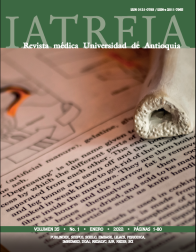Impacto de la implementación de la estrategia del Aprendizaje Basado en Casos (ABC) en estudiantes de prácticas clínicas en fisioterapia
DOI:
https://doi.org/10.17533/udea.iatreia.98Palabras clave:
aprendizaje basado en problemas, educación médica, informes de casos, rehabilitaciónResumen
Introducción: el Aprendizaje Basado en Casos (ABC) es una estrategia pedagógica por descubrimiento que permite la articulación de los conocimientos nuevos con los ya adquiridos, estimula la autonomía, desarrolla el pensamiento crítico y las competencias argumentativas en contextos reales, desarrollando la fase del “saber” según lo explica la pirámide de Miller.
Objetivo: evaluar el impacto en la motivación y en el aprendizaje que produce la implementación de la estrategia del ABC en estudiantes del último nivel de Fisioterapia.
Metodología: diseño mixto cuasiexperimental con 12 estudiantes y 3 profesores. Se desarrolló resencialmente en horas de asesorías durante 18 semanas, cada 15 días con 2 horas por encuentro. La información fue recolectada a través de pruebas de conocimiento antes y después de la intervención, grupos focales con estudiantes y docentes y observaciones no participantes.
Resultados: se evidenciaron cambios significativos entre la evaluación pre y la post intervención (16,7 %; 83,3 %, p < 0,05). Los estudiantes describieron la experiencia como altamente motivante y los docentes como enriquecedora.
Discusión: esta investigación sustenta el efecto del ABC en el aprendizaje activo y la mediación pedagógica desarrollada por el profesor a través de las fases de la estrategia.
Conclusión: el Aprendizaje basado en casos implementado de manera sistemática, organizada y planeada es una estrategia útil en el proceso de formación de los fisioterapeutas. Promueve el desarrollo de la capacidad crítica, reflexiva y analítica y el logro de las competencias profesionales.
Descargas
Citas
(1) Pérez-Escoda N, Aneas Álvarez A. La metodología del caso: un poco de historia. En: Metodología del caso en Orientación. Barcelona: Universidad de Barcelona; 2014.p. 8-13.
(2) Leon JS, Winskell K, McFarland DA, Del Rio C. A casebased, problem-based learning approach to prepare master of public health candidates for the complexities of global health. AJPH. 2015;105(1):S92-6. DOI 10.2105/AJPH.2014.302416.
(3) Kaddoura M. Critical thinking skills of nursing students in lecture-based teaching and case-based learning. Int J Scholarsh Teach Learn. 2011;5(2):1-18.
(4) Thistlethwaite JE, Davies D, Ekeocha S, Kidd JM, MacDougall C, Matthews P, Et al. The effectiveness of case-based learning in health professional education. A BEME systematic review: BEME Guide No. 23. Med Teach. 2012;34(6):e421-44. DOI 10.3109/0142159X.2012.680939.
(5) Pinilla AE. Modelos pedagógicos y formación de profesionales en el área de la salud. Acta med. colomb. 2011;36(4). DOI 10.36104/amc.2011.1451.
(6) Tobon S. Formación integral y competencias. Pensamiento complejo, currículo, didáctica y evaluación. 4. Ed. Bogotá: ECOE; 2013.
(7) Gómez Esquer F, Rivas Martínez I, Mercado Romero F, Barjola Valero P. Aplicación interdisciplinar del aprendizaje basado en problemas (ABP) en Ciencias de la Salud: una herramienta útil para el desarrollo de competencias profesionales. Red U. 2009;7(4). DOI 10.4995/redu.2009.6228.
(8) Herrera Villabona E, Rivera Celis L, Prada Pérez A, Sánchez Rámirez D. Evolución histórica de la fisioterapia en Colombia y en la Universidad Industrial de Santander. Salud UIS. 2004;36:21-31.
(9) Pinzón CE. Los grandes paradigmas de la educación médica en Latinoamérica. Acta med. colomb. 2008;33(1):33-41.
(10) Rodriguez E. Aplicación de la enseñanza basada en la resolución de casos clínicos en la asignatura “Fisioterapia en afecciones musculoesqueléticas” en el Centro de Ciencias de la Salud de San Rafael-Nebrija de Madrid [Trabajo de grado Doctorado en Innovación y formación del profesorado]. Madrid: Universidad Autónoma de Madrid; 2014.
(11) Gardner M. Mixed Methods Research. En: Fraenkell J, Wallen N, Hyun H. How to design and evaluate research in education. 8. Ed. Nueva York. McGraw-Hill; 2012. p. 1689-99.
(12) Braeckman L, ‘t Kint L, Bekaert M, Cobbaut L, Janssens H. Comparison of two case-based learning conditions with real patients in teaching occupational medicine. Med Teach. 2014 Apr;36(4):340-6. DOI 10.3109/0142159X.2014.887833.
(13) Khosa DK, Volet SE. Promoting effective collaborative case-based learning at university: A metacognitive intervention. Stud High Educ. 2013;38(6):870-89. DOI 10.1080/03075079.2011.604409.
(14) Polit DF, Beck CT. The content validity index: are you sure you know what’s being reported? critique and recommendations. Res Nurs Health. 2006;29(5): 489-97.
(15) Sampieri Hernández R, Mendoza Torres C. Metodología de la investigación las rutas cuantitativa cualitativa y mixta. Mexico: McGraw-Hill Interamericana; 2018.
(16) Salas Perea RS. Principios y enfoque bioéticos en la Educación Médica Cubana. Educ Med Super. 1996;10(1):7-8.
(17) Kumar A, Vandana V, Aslami A. Introduction of “case-based learning” for teaching pharmacology in a rural medical college in Bihar. Natl J Physiol Pharm Pharmacol. 2016;6(5):427-30. DOI 10.5455/njppp.2016.6.0411305052016.
(18) McLean M, Brazil V, Johnson P. How we “breathed life” into problem-based learning cases using a mobile application. Med Teach. 2014 Oct;36(10):849-52. DOI 10.3109/0142159X.2014.886771.
(19) Durante E. Algunos métodos de evaluación de las competencias: Escalando la pirámide de Miller. Rev Hosp Ital BAires. 2006;26(2):55-61.
(20) Robles J. Hopkins D. Every school a great school: Realizing the potential of system leadership. J Educ Change. 2008;9:213–5. DOI 10.1007/s10833-008-9067-9.
(21) Ching YH. Exploring the impact of role-playing on peer feedback in an online case-based learning activity. IRRODL. 2014;15(3). DOI 10.19173/irrodl.v15i3.1765.
(22) Dow M, Boettcher C, Diego J, Karch M, Todd-Diaz A, Woods K. Case-based Learning as Pedagogy for Teaching Information Ethics Based on the Dervin Sense-Making Methodology. J Educ Libr Inf Sci Online. 2015;56(2):141-57.
Publicado
Cómo citar
Número
Sección
Licencia
Derechos de autor 2021 Universidad de Antioquia

Esta obra está bajo una licencia internacional Creative Commons Atribución-NoComercial-CompartirIgual 4.0.
Los artículos publicados en la revista están disponibles para ser utilizados bajo la licencia Creative Commons, específicamente son de Reconocimiento-NoComercial-CompartirIgual 4.0 Internacional.
Los trabajos enviados deben ser inéditos y suministrados exclusivamente a la Revista; se exige al autor que envía sus contribuciones presentar los formatos: presentación de artículo y responsabilidad de autoría completamente diligenciados.














